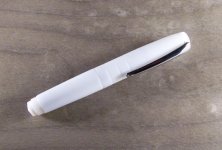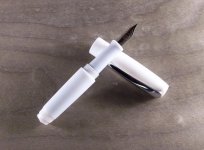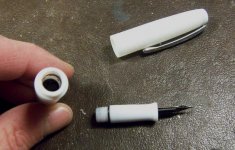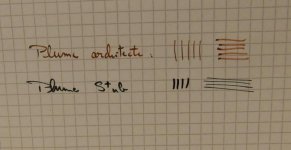Today I show you a little fountain pen (11 cm length), in fact I turned it because I wanted to test several things. I have not been always successful but I hope you will find it interesting.
First, the material: it's made of Teflon (PTFE). I wanted to give it a try, I now know it's a pretty ugly plastic, I'm not found of it...
On the other hand, it is very hard: I knock it with a very big hammer and it did not even open an eye.
Second, the shape. It is due to given constraints : the body had to be very short to take less place in the pocket (L total 11 cm), with a clip though, but it should contain a huge reserve of ink (?!!??!). The cap had to be postable, just in case. So I played with the shape, the joint between body and cap is not where one think it is...:


Third, the feeding system, because of the constraint already mentioned about the quantity of ink needed: it is an eyedropper, that is to say the ink is poured directly into the body. To avoid leaking, I put an O-ring between section and body (this is the small black ring stuck on the section), plus silicone grease on the threads: no leak! The advantage is that it contains a lot of ink for a long day of writing (2 ml, the equivalent of two cartridges for the length of one):

Finally, I did a lot of nibs regrinding tests. This one has been re-cut in "architect" style, it writes horizontally wide and vertically fine, it is the opposite of the "stub". It is comfortable to know that I can say yes to some requests, of course providing a pen that does not scratch and flows well, but also being able to grind specific shapes (architect, stub, oblique italic, FFF , etc.) that give character to the writing, more than with a usual round tip:

Close up on an architect: and on a stub:
and on a stub: 
In order to thank you for your attention, here is a more conventional pen, made of golden horn with black horn section. And Phil's clip, I'm a fan.
C & c's welcome!

.
First, the material: it's made of Teflon (PTFE). I wanted to give it a try, I now know it's a pretty ugly plastic, I'm not found of it...

On the other hand, it is very hard: I knock it with a very big hammer and it did not even open an eye.
Second, the shape. It is due to given constraints : the body had to be very short to take less place in the pocket (L total 11 cm), with a clip though, but it should contain a huge reserve of ink (?!!??!). The cap had to be postable, just in case. So I played with the shape, the joint between body and cap is not where one think it is...:


Third, the feeding system, because of the constraint already mentioned about the quantity of ink needed: it is an eyedropper, that is to say the ink is poured directly into the body. To avoid leaking, I put an O-ring between section and body (this is the small black ring stuck on the section), plus silicone grease on the threads: no leak! The advantage is that it contains a lot of ink for a long day of writing (2 ml, the equivalent of two cartridges for the length of one):

Finally, I did a lot of nibs regrinding tests. This one has been re-cut in "architect" style, it writes horizontally wide and vertically fine, it is the opposite of the "stub". It is comfortable to know that I can say yes to some requests, of course providing a pen that does not scratch and flows well, but also being able to grind specific shapes (architect, stub, oblique italic, FFF , etc.) that give character to the writing, more than with a usual round tip:

Close up on an architect:
 and on a stub:
and on a stub: 
In order to thank you for your attention, here is a more conventional pen, made of golden horn with black horn section. And Phil's clip, I'm a fan.
C & c's welcome!

.


